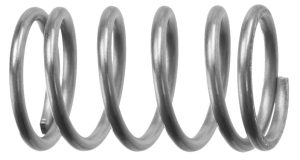
Compression springs are characterized by their ability to compress and, thus, become shorter under a load. They consist of a single piece of coiled metal wire. When exposed to a compressive force, compression springs will become shorter while simultaneously storing this mechanical energy. While all compression springs use this same design, they are available in different end configurations.
Closed and Squared
One of the most common end configurations for compression springs is closed and square. If you inspect a compression spring with closed and square ends, you may notice that the last two coils on each coil are close together. The last two coils on the ends are essentially “closed,” resulting in little or no gap between them. With closed and squared ends such as this, compression springs can stand upright without falling over.
Closed and Ground
In addition to closed and squared, there’s the closed and ground end configuration. The last two coils on each end have little or no gap between with them — just like with their closed and squared counterpart. So, what’s the difference between closed and squared ends and closed and ground ends?
Compression springs with closed and ground ends undergo an additional step during production: grinding. First, the ends of the compression spring are closed by bringing the last two coils on each end closer together. Next, a grinding tool is used to grind down the ends. By grinding the ends, the compression spring will become stable and experience less buckling when standing upright.
Open
Compression springs are available with open ends as well. Open ends mean the last two coils on each end aren’t closed. Instead, the distance or pitch between the last two coils on each end is roughly the same as the other coils. Compression springs with open ends don’t offer the same vertical stability as their closed counterparts. To stand upright, they often require some type of additional support, such as a rod. Open ends, however, are cost-effective and easy to produce.
In Conclusion
Most compression springs have one of two primary end types: closed or open. Closed ends are the most common. Some compression springs have closed and square ends, whereas others have closed and ground ends. They both involve shortening the distance between the last two coils on the ends, but closed and ground ends are ground down to achieve better stability. Open ends, in comparison, consist of a simpler design in which the last two coils on the ends are open and not closed.
